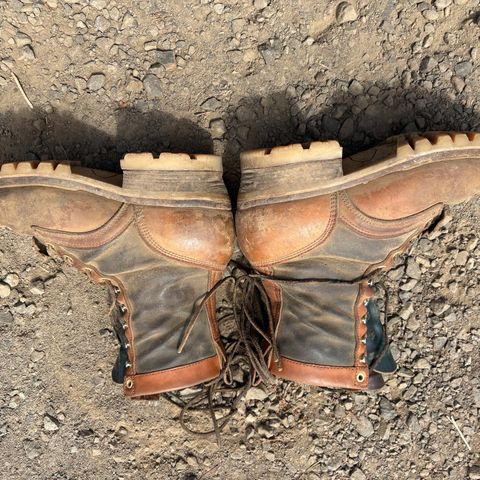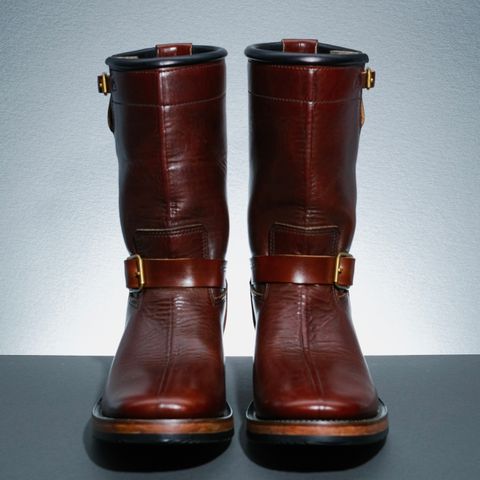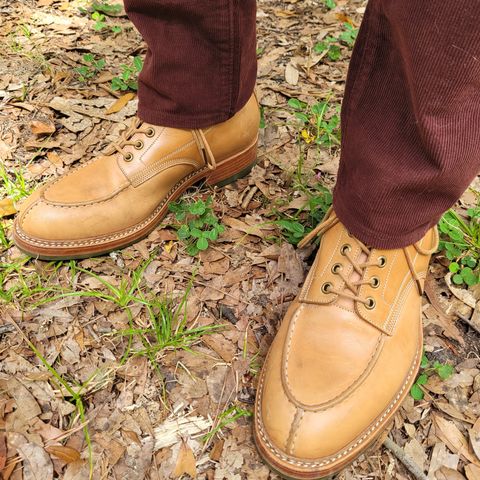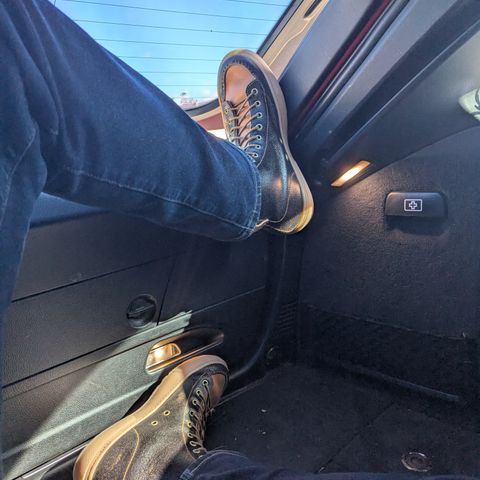About
Traditional Harness is a vegetable-tanned leather produced by Wickett & Craig, one of only two remaining vegetable tanneries in the United States. The leather is hot stuffed with an exclusive blend of waxes, oils, and tallows, then finished through a traditional jack glazing process that creates a distinctive glossy surface while preserving the natural grain. Traditional Harness is considered among the highest end vegetable tanned leathers in the world, valued for its rich colors, durability, and ability to develop a beautiful patina over time.
About
Traditional Harness is a vegetable-tanned leather produced by Wickett & Craig, one of only two remaining vegetable tanneries in the United States. The leather is hot stuffed with an exclusive blend of waxes, oils, and tallows, then finished through a traditional jack glazing process that creates a distinctive glossy surface while preserving the natural grain. Traditional Harness is considered among the highest end vegetable tanned leathers in the world, valued for its rich colors, durability, and ability to develop a beautiful patina over time.
The leather is manufactured at Wickett & Craig's facility in Curwensville, Pennsylvania, where the tannery has operated since relocating from Toronto, Canada in 1989. Traditional Harness is available in weights ranging from 2-3 oz. to 13-15 oz., making it suitable for both equestrian gear and leather goods when split to lower weights. The leather is offered in nine standard colors and features characteristics that distinguish it from the company's other premium product, English Bridle leather.
Manufacturing
Traditional Harness undergoes a vegetable tanning process that takes 14 days in a tree bark solution. After tanning, the leather is hot stuffed with an exclusive blend of waxes, oils, and tallows to bring out the inherent beauty of the leather and its natural grain. This process infuses conditioning agents throughout the leather that contribute to its characteristic aging properties.
The defining feature of Traditional Harness is the jack glazing process, an ancient traditional technique where the leather surface is beaten by a glass roll. Through this glazing process, oils are brought to the surface to create a glossy finish that never masks the leather's natural grain. The hot stuffing and jack glazing processes together distinguish Traditional Harness from other leathers in the Wickett & Craig product line, including English Bridle, which receives different finishing treatments.
Characteristics
Traditional Harness exhibits a glossier top grain surface compared to English Bridle, which features a more matte finish. The leather shows more marbling with light and dark color tones distributed across the hide, whereas English Bridle presents a more uniform color appearance. This marbling is a natural characteristic of the jack glazing process and varies from hide to hide.
The leather is classified as firm and preserves the natural grain pattern of the hide. The rich texture develops a unique patina over time through natural aging, with the leather improving with age. The beautiful top side stamps and tools easily if desired, making it suitable for applications requiring decorative work.
Fine hairline marks may appear from the glazing process and can be buffed back using a dry cloth and neutral cream while rolling the grain surface over. The leather contains conditioning agents from the hot stuffing process that help it develop its characteristic patina with natural use, requiring minimal additional care.
Applications
Traditional Harness is ideal for equestrian gear, the application for which it was originally developed. When split to lower weights, the leather becomes equally suitable for leather goods including wallets, small goods, footwear, bags, and briefcases. The leather is used for high-end accessories, belts, and shoes, as well as traditional equestrian equipment including bridles, saddles, and straps.
The versatility of Traditional Harness across different weight ranges allows it to serve both heavy-duty applications requiring maximum durability and lighter applications where a refined appearance is desired. The availability in lighter weights has led to increased use in the footwear market, where Wickett & Craig has been expanding in recent years.
Comparison to English Bridle
Traditional Harness and English Bridle represent two distinct finishing approaches to vegetable-tanned leather from Wickett & Craig. While both leathers are hot stuffed with waxes, oils, and tallows, English Bridle is drum dyed before hot stuffing, whereas Traditional Harness proceeds directly to jack glazing after hot stuffing.
English Bridle has less oil content than Traditional Harness, giving it a drier feel when working with the leather. The surface finish differs significantly, with Traditional Harness presenting a glossy appearance from jack glazing compared to English Bridle's matte finish. The color presentation also differs, with Traditional Harness showing marbling across the hide while English Bridle maintains more uniform coloration.
Both leathers feature gum pasted back sides that provide a waxy, smooth texture. English Bridle is available in weight ranges from 2-3 oz. to 12-14 oz., compared to Traditional Harness's range of 2-3 oz. to 13-15 oz. Both leathers are produced at the same Pennsylvania facility and share average dimensions of 24-27 square feet for sides and 18-20 square feet for backs.
Available Options
Traditional Harness is offered in nine standard colors: Russet, Medium Brown, Burgundy, Buck Brown, Black, Navy, Olive, Gray, and Chocolate. The leather is available in three grade levels: Standard, Utility, and Special, allowing customers to select based on quality requirements and budget considerations.
The leather can be ordered with custom splitting to achieve specific thickness requirements beyond the standard weight ranges. Custom refinishing services are also available for specialized applications. Average side dimensions are 24-27 square feet and average back dimensions are 18-20 square feet, though individual hides vary based on the source animal.
References
"Traditional Harness". Wickett-Craig. Retrieved October 9, 2025.
"Wickett & Craig Leather". Buckleguy. Retrieved October 9, 2025.
"English Bridle". Wickett-Craig. Retrieved October 9, 2025.























































